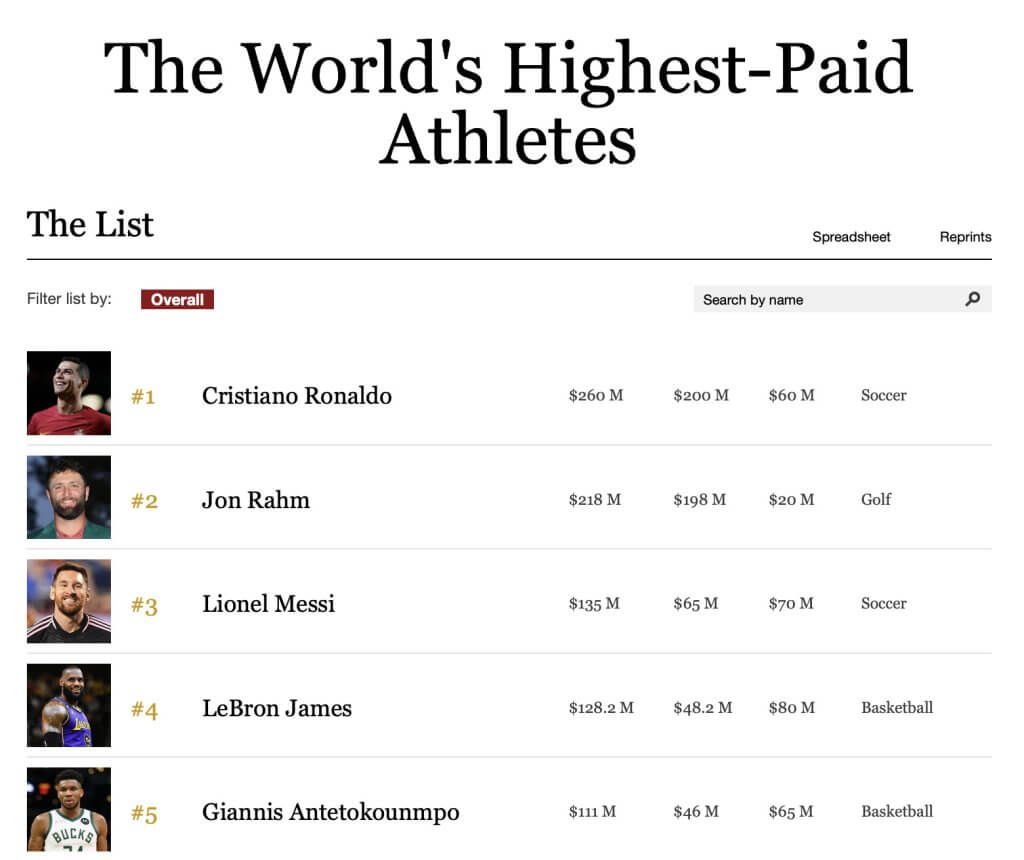A personal brand encompasses all publicly available information about an individual and the way it is perceived by the audience. Research conducted by Brand Builders Group found that 74% of people are more likely to trust someone who has an established personal brand.
However, the need for a strong media presence extends beyond business owners and top executives. Public figures, recognised professionals, as well as artists and athletes, also greatly benefit from cultivating a personal brand. This article will focus on the latter group.
Table of Contents
Sport in the Media Landscape
Today, sport has become as much a business as manufacturing, retail, or the IT sector. At the same time, sport has evolved into a media phenomenon, becoming an integral part of popular culture. Today, the specific term “MediaSport” has emerged — it refers to the combination of the sport itself, all related information, as well as the channels through which this information is disseminated and its target audience. The most striking example of this concept is the Olympic Games, which were revived by enthusiasts at the very end of the 19th century. What, then, is the unique nature of sport, and what role does it play in people’s lives?
Sport is immensely popular. The opening ceremonies of the Olympic Games are watched by billions of people. It dominates audience reach and continuously attracts new fans. Sport is associated with a healthy lifestyle, personal development, and success, which only enhances interest in it. Many public figures — musicians, actors, politicians, members of royal families, and others — proudly declare their engagement in various forms of physical activity.
Sport is captivating. The competitive element draws in the audience, offering them the chance to share the joy of victory or the bitterness of defeat. Fans differ from ordinary spectators in their deeper emotional investment in what they watch, whether from the stands or on screen. These individuals not only follow sporting events themselves but also encourage others — family members, colleagues, and friends —to get involved.
Sport is widely endorsed. Many major countries, East or West, enjoy strong support from their respective governments keen to promote a healthy lifestyle and the social well-being of the population, often starting with the young. On an international level, the importance of investing in sport has been increasingly recognised as a key driver of sustainable development. A global report previewed by the Commonwealth Secretariat and UNESCO highlighted sport’s contributions to health, education, gender equality, social inclusion, and economic growth. The report emphasises that every dollar invested in sport delivers a positive return, helping to create healthier, more productive societies. It also stresses that investment in sport can serve as a catalyst for transformation, making a measurable impact both nationally and globally.
Sport is lucrative. In 2023, the 50 highest-paid athletes collectively earned nearly four billion dollars. Sport attracts a wide range of sponsors, from food manufacturers to software developers. According to the sports information and data agency Horizm, in 2022, global brands generated €80 million solely from sports media platforms.
Most popular sports in the world by number of players

Source: https://news.topsport.com.au/ranked-the-worlds-most-popular-sports/
In the 21st century, the boundaries of traditional sports have significantly expanded with the rise of eSports. Like conventional sports, eSports is rooted in competition and is rapidly growing, driven primarily by a young audience. Projections suggest that by 2025, the global eSports audience will exceed 640 million people. This expanding viewership is attracting a growing number of sponsors. For instance, the eSports organisation Team Liquid counts among its partners a gaming PCs and peripherals manufacturer, a cryptocurrency exchange platform, and a global energy drinks brand.
In this evolving landscape, the role of athletes is also changing. They are no longer merely participants in competitions. With the advancement of communication technologies, athletes now have the ability to convey personal messages directly to their audience and shape their own media narratives. The media image of the athlete has become a crucial factor in this process.
The Personal Brand of an Athlete
An athlete’s personal brand is shaped by how their character is perceived by others, which is influenced by social media messages, media publications, and search engine results. In an age where information is widely accessible, athletes, like other public figures, strive to be more transparent. As competition in the media landscape intensifies, establishing trust with the audience and maintaining existing relationships has become increasingly valuable. This, in turn, allows athletes to convert their fame into financial gain.

An athlete possesses unique talents and holds a respected position within society. Sport can serve as a strong driver of upward social mobility. Sport provides significant opportunities even after the end of a professional career. However, the success of a media career largely depends on building relationships with both the audience and the media.
A well-developed personal brand makes an athlete attractive to advertisers. For example, tennis player Maria Sharapova earned approximately $300 million over her career, with official earnings from competitions amounting to only $39 million. That’s just short of 13% which came from her time on the court. Throughout her sporting career, she collaborated with numerous brands including Nike, Pepsi, and Porsche and, in 2012, Maria even launched her own company, Sugarpova.

Maria Sharapova at the launch event for the Porsche Panamera GTS, photo from motorauthority.com.
This scenario is also typical for other top athletes. In 2023, tennis player Daniil Medvedev earned over $20 million, with nearly two-thirds — $13 million — coming from endorsements and other income sources. Medvedev currently has long-term partnerships with nine sponsors, including major brands such as BMW, Bovet, and Lacoste. With Lacoste, he launched his own line of clothing and footwear. Additionally, he has begun collaborating with the energy bar manufacturer RawQ.

Daniil Medvedev wearing a Bovet watch, as featured on the manufacturer’s website
Among the world’s top-earning athletes, Cristiano Ronaldo stands out as the highest-paid. According to Forbes, in 2024, Ronaldo made $260 million, with $60 million coming from endorsements. His brand power has attracted deals with major companies such as Nike, Armani, TAG Heuer, and Herbalife. Notably, Ronaldo is one of the few athletes to have a lifetime sponsorship deal with Nike, cementing his legacy both on and off the pitch.

Cristiano Ronaldo is reportedly paid £147 million to be sponsored by sportswear giant Nike (Credit: Instagram*)
In the number two position among the world’s top-earning athletes is golfer Jon Rahm. Rahm signed a lucrative three-year deal with the Saudi-backed LIV Golf Tour in December, which contributed to his total earnings of $218 million. Of this, $198 million came from playing wages alone. As of June 2024, Rahm has endorsement deals with Callaway Golf, Mercedes-Benz, Rolex, and Santander Group, bringing in $20 million annually from these partnerships.

Pro golfer Jon Rahm and the Mercedes-Benz EQS SUV unite, driven by a shared commitment to redefine greatness (Credit: Mercedes, Facebook*).
Lionel Messi, currently in third place, has earnings totaling $135 million, with more than half — $70 million — coming from off-the-field activities. Messi’s strong personal brand is highlighted by his lifetime contract with Adidas, the most lucrative of his endorsements. He also has deals with Budweiser, Mastercard, Pepsi, Saudi Arabian tourism, and Socios.

Messi has a lifetime contract with Adidas, which supplies kits for all MLS teams (Credit: SportsPro Media).
However, outstanding athletic achievements are not always the sole focus. For example, German athlete Alica Schmidt, despite modest performances in international competitions, has amassed over six million followers on Instagram and has cultivated an image as one of the world’s most attractive athletes. Schmidt is also one of the most popular German sports figures. She has a contract with Puma and collaborates with manufacturers of sports nutrition and dietary supplements. Additionally, Schmidt has launched an exclusive clothing collection in partnership with BOSS.

Alica Schmidt showcases her own clothing line on the BOSS website.
Moreover, an athlete doesn’t need to be actively competing to develop a strong personal brand. Former champions or members of national teams can still be in demand with audiences and the media. Retired athletes often participate in podcasts, talk shows, and radio broadcasts, where they share their professional experiences or comment on current events. However, it’s crucial to start building a media presence early — while still competing, when the individual already has some level of recognition. A personal brand should be based on the athlete’s strengths, aligned with the expectations of the target audience, and possess a unique identity.
Peculiarities of Building an Athlete’s Personal Brand
Research shows that athletes are highly attractive to business partners. Influencers in the “sports” category are among the most sought-after by companies. According to Statista, global investment in sports sponsorship reached $66.1 billion in 2022 and is projected to surpass $100 billion by 2030, with a significant portion allocated to athlete endorsements and partnerships. To secure these lucrative deals, a strong, well-crafted personal brand is essential.
The foundational idea for developing an athlete’s personal brand is their positioning. To engage an audience, the athlete must convey a specific set of values, which requires a carefully crafted promotion strategy.
Until recently, the media promotion of professional athletes was primarily managed by large international sports and PR agencies, such as Creative Artists Agency, Wasserman, Boras Corporation, IMG, and others. These agencies manage hundreds of athletes simultaneously, including top-tier stars. In recent years, however, smaller creative agencies (boutique agencies) have entered the sports consulting market, rapidly becoming competitive players. Notable athletes like Roger Federer, Rafael Nadal, and others have already become clients
The advantage of boutique agencies lies in their niche focus. Such organisations specialise in specific areas and often possess expertise in unique fields. Additionally, small agencies offer a personalised approach to each client, with a deep dive into every individual case.
Positioning involves focusing on a specific group of people while simultaneously expanding the overall audience. To achieve this, in addition to sports-related content, it is necessary to publish lifestyle content as well. The athlete’s efforts should be directed towards deepening engagement with both the audience and advertisers.
It is essential to study their needs and expectations and align them with your capabilities. In most cases, these will be fans of the sport in which the athlete competes. Next, it is important to determine which sponsors’ support can be expected in the future. Additionally, it is necessary to study the market and successful examples of other athletes. Based on this, a content strategy should be developed.
The content can take various forms, including short video messages, live broadcasts, and posts on different platforms. An athlete might comment on key sporting events, share training methods, or offer advice on healthy eating. The posts don’t necessarily have to be related to sports; they could also be lifestyle content that provides insight into the person’s daily life. The general rule is that content should be released regularly and be unique; otherwise, it won’t attract an audience.
Equally important are the communication channels: social media, traditional media, and search engine visibility. Each platform has its unique characteristics, which should be taken into account when promoting a personal brand.
Social media is the most accessible communication channel, allowing for a close connection with the audience and offering a quick response to external events. Additionally, social media opens up significant opportunities for interaction with other stakeholders, including fellow athletes, advertisers, or fan communities. These platforms enable the sharing of both official and personal content, as well as the publication of sponsored material.
Social media has enabled even emerging athletes, who may not yet have notable victories in their careers, to gain recognition. Sponsors can be drawn to an athlete’s presentation style or distinctive personal traits. The image crafted on these platforms must be positive, as they most accurately reflect the athlete’s personality. For example, Jujimufu (Jon Call), an American fitness enthusiast and trickster, gained significant recognition online despite not being a professional athlete or champion. With over 1.7 million followers on Instagram and 1.5 million on YouTube, Jujimufu became famous for his entertaining strength stunts, extreme flexibility, and humorous approach to fitness. His persona as a fun, approachable “everyman” with impressive physical abilities has caught the attention of fitness enthusiasts and brands worldwide.
Traditional media outlets provide the opportunity to reach the widest possible audience. Moreover, conventional sources of information tend to enjoy greater public trust. In Europe, for example, 71% of respondents report that television remains one of their most frequently used media sources for news, followed by online news platforms (42%). Radio and social media platforms (both 37%) share the third position, while the written press is still used by 21% of respondents. Content like interviews, opinion pieces, and expert commentary are particularly effective in conveying an athlete’s personal brand and values through these trusted channels.
Personal search results consider an individual’s entire media presence, ranking it according to various criteria, including search history, geographic location, device type, and other factors. This means the results can include not only positive or neutral content but also negative publications. Effective management of reputational risks is essential for successfully promoting an athlete’s personal brand — neglecting this can damage the brand and undermine the overall media strategy.
Athletes must also carefully evaluate every action that could affect their media image. Failure to do so can lead to significant reputational and financial losses. A notable example is NBA star Kyrie Irving, who in 2022 shared a link to discriminatory content on social media. This led Nike to suspend a contract worth $11 million per year. Subsequently, the athlete signed a five-year deal with the Chinese sports brand ANTA.

Kyrie Irving showcasing ANTA products. (Credit: ANTA Sports, Instagram)
Building a personal brand requires a consistent stream of outgoing information. Without this, interest in even the most accomplished athletes can wane. It is essential to maintain media presence consistently across all chosen platforms. Establishing a personal brand takes a minimum of six months, a timeline that should be factored into any content strategy. Long-form content and collaborations with other media figures are particularly effective in keeping an athlete visible in the public eye.
A strategic blend of content formats, communication channels, thoughtful content planning, and proactive management of negative press is key to crafting a persona that resonates with the target audience. However, the approach to promoting an athlete’s personal brand is unique to each individual. For optimal results, it’s important to engage professional support, such as ADVES, a leading full-service digital agency specialising in online reputation management.
Conclusion
A personal brand is valuable for both emerging and established athletes. Having a presence in the media landscape enhances an athlete’s visibility, attracting a broader audience and potential sponsors. The more followers an athlete has, the more lucrative the sponsorship opportunities become. A successful personal brand not only facilitates the promotion of third-party products but also enables the creation of one’s own offerings, such as online courses, lectures, or personalised training programmes. This is particularly beneficial during periods of rising popularity. Moreover, cultivating a personal brand does not hinder the development of a professional sports career. Experts advise dedicating only 5% of one’s attention to building a media image in the early stages, with the remaining 95% focused on athletic performance.
Investing in a personal brand allows athletes to explore new career avenues, maintain, and even amplify their popularity. Consequently, even after retiring from professional sports, an athlete can sustain a high level of income. With a strong personal brand, they can launch new ventures in any field, attract investments, and generate profits.
A personal brand also helps athletes feel relevant and in demand. Through established communication channels, they can share their expertise or receive attractive partnership offers. Even athletes without outstanding achievements can find success in the media space if their personal brand resonates with the audience.
Building a strong personal brand requires time and the careful management of reputational risks. Even in the absence of immediate results, it is essential to stay engaged with the audience and remain active across all chosen platforms. For expert assistance in personal brand promotion, athletes should turn to professionals.
*Meta is banned in Russia as an extremist organization
FAQ
Why is it important for an athlete to have a personal brand?
A personal brand attracts audiences and advertisers, enabling the monetisation of an athlete’s media presence.
How can an athlete start building a personal brand?
An athlete should define their positioning, create relevant content, and choose the appropriate media platforms for its distribution.
How can a personal brand impact an athlete’s career?
A personal brand helps athletes gain recognition. It draws in audiences and investors, thereby increasing the athlete’s income.


